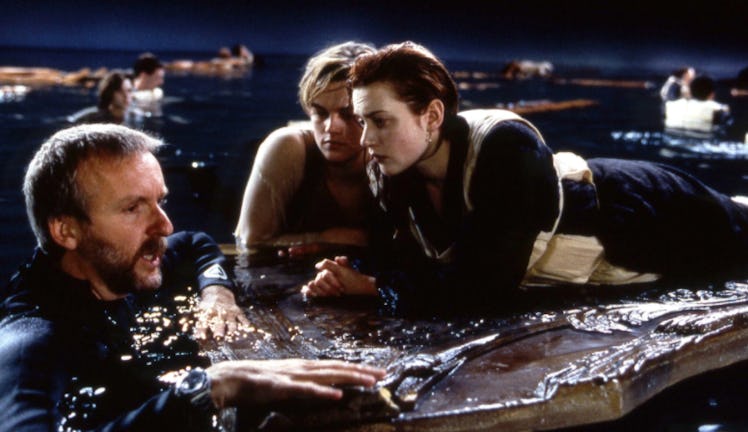
James Cameron Wants You To Know That Jack "Had To Die" In 'Titanic,' So Get Over It
In today's day and age, there are a few surefire ways to start a full-blown war with a '90s kid: 1) insult Britney Spears, 2) delete their Pokémon GO! app, and 3) say that Jack and Rose both couldn't have fit on that door at the end of Titanic. Well, take a deep breath, kids, because it looks like number 3 might actually be true. That's right, according to Titanic's director, James Cameron, Jack had to die at the end of Titanic; so, regardless of whether or not Jack and Rose both could have fit on that door, Leo was getting the axe.
I know what you're thinking right about now: "Bullsh*t, FAKE NEWS, I will not let an internet article ruin my life again." While I share your outrage, I'm sorry to say it is true. In a recent interview with Vanity Fair, James Cameron explains that Jack had to die in the film; the director doesn't hold anything back when he addresses the two-decade old issue of the door, saying "The answer is very simple because it says on page 147 [of the script] that Jack dies."
There ya have it, infuriating as it may be, it comes from the mouth of the director himself. Near, far, wherever you are, Jack dies.
Cameron continues to give insight into the film's controversial ending by explaining the choice to have Jack die and the impossibility of his survival in that situation; he says,
Very simple. . . . Obviously it was an artistic choice, the thing was just big enough to hold her, and not big enough to hold him . . . I think it’s all kind of silly, really, that we’re having this discussion 20 years later. But it does show that the film was effective in making Jack so endearing to the audience that it hurts them to see him die. Had he lived, the ending of the film would have been meaningless. . . . The film is about death and separation; he had to die. So whether it was that, or whether a smoke stack fell on him, he was going down. It’s called art, things happen for artistic reasons, not for physics reasons.
If you're still not satisfied, though, Cameron goes on to explain exactly why the board wouldn't have been able to hold both Jack and Rose; the director says,
I was in the water with the piece of wood putting people on it for about two days getting it exactly buoyant enough so that it would support one person with full free-board, meaning that she wasn’t immersed at all in the 28 degree water so that she could survive the three hours it took until the rescue ship got there. [Jack] didn’t know that she was gonna get picked up by a lifeboat an hour later; he was dead anyway. And we very, very finely tuned it to be exactly what you see in the movie because I believed at the time, and still do, that that’s what it would have taken for one person to survive.
As upsetting as Cameron's explanation is, it doesn't change the film's popularity with fans or its status in the film world as a modern cinematic masterpiece. Indeed, later this year, 20 years after its original theatrical release, Titanic is headed back to theaters for a third time — this time for a one-week-only run in 87 select Dolby Cinema theaters beginning on December 1.
“We mastered a few minutes of Titanic in Dolby Vision and I was stunned,” Cameron said in a statement on Titanic's rerelease. “It was like seeing it for the first time. Now that the entire film has been mastered, I’m excited to share it with audiences across the U.S. This is beyond 3D, beyond 70mm, it’s beyond anything you’ve seen before. The image leaps off the screen as bright and vibrant as life itself. This is the way all movies should be seen and without a doubt, Titanic has never looked better.”
I guess now all that's left to do is sob through Titanic in 3D and hope that in the next rerelease Cameron pulls some sh*t and lets Jack live. We can always dream, right?
Check out the entire Gen Why series and other videos on Facebook and the Bustle app across Apple TV, Roku, and Amazon Fire TV.